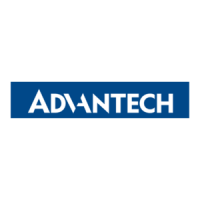E-2 ADAM 4000 Series User's Manual
RS-485 Network
ADAM modules are fully isolated and use just a single set of twisted pair
wires to send and receive! Since the nodes are connected in parallel they
can be freely disconnected from the host without affecting the functioning
of the remaining nodes. In industry shielded twisted pair is preferable due
to the high noise ratio of the environment.
When nodes communicate through the network, no sending conflicts can
occur since a simple command/response sequence is used. There is always
one initiator (with no address) and many slaves (with address). In this case
the master is a personal computer that is connected with its serial, RS-232,
port to an ADAM RS-232/RS-485 converter. The slaves are the ADAM I/
O modules. When modules are not transmitting data, they are in listen
mode. The host computer initiates a command/response sequence with one
of the modules. Commands normally contain the address of the module the
host wants to communicate with. The module with the matching address
carries out the command and sends its response to the host.
E.1 Basic Network Layout
Multi-drop RS-485 implies that there are two main wires in an segment.
The connected modules tap from these two lines with so called drop cables.
Thus all connections are parallel and connecting or disconnecting of a node
doesn’t affect the network as a whole. Since ADAM modules use the RS-
485 standard, and use an ASCII-based commands set, they can connect and
communicate with all ASCII-based computers and terminals. The basic
layouts that can be used for an RS-485 network are:
Daisychain
The last module of a segment is a repeater. It is directly connected to the
main-wires thereby ending the first segment and starting the next segment.
Up to 32 addressable modules can be diasychained . This limitation is a
physical one. When using more modules per segment the IC driver current
rapidly decreases, causing communication errors. Totally the network can
hold up to 256 addressable modules. The limitations for this number is the
two number hexadecimal address code that knows 256 combinations. The
ADAM converter, ADAM repeaters and the host computer are non
addressable units and therefore are not included in these numbers.
